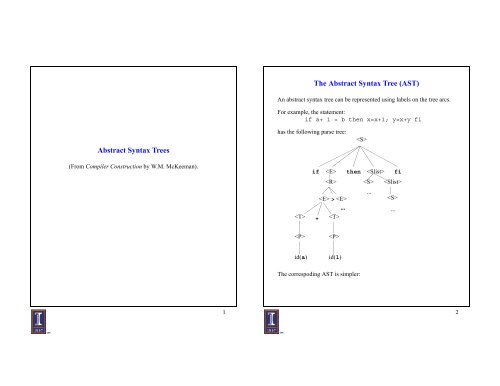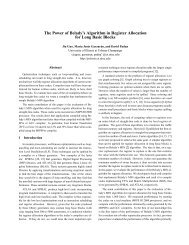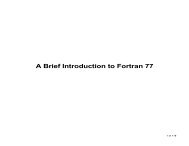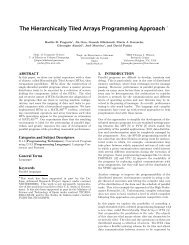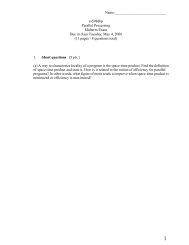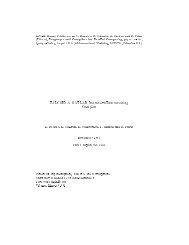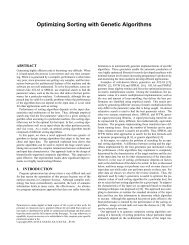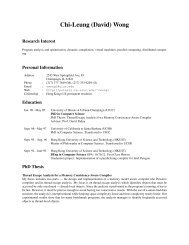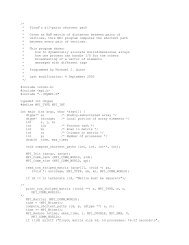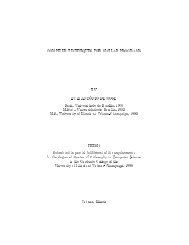Abstract Syntax Trees The Abstract Syntax Tree (AST) - Polaris
Abstract Syntax Trees The Abstract Syntax Tree (AST) - Polaris
Abstract Syntax Trees The Abstract Syntax Tree (AST) - Polaris
You also want an ePaper? Increase the reach of your titles
YUMPU automatically turns print PDFs into web optimized ePapers that Google loves.
<strong>The</strong> <strong>Abstract</strong> <strong>Syntax</strong> <strong>Tree</strong> (<strong>AST</strong>)<br />
An abstract syntax tree can be represented using labels on the tree arcs.<br />
For example, the statement:<br />
if a+ 1 > b then x=x+1; y=x+y fi<br />
<strong>Abstract</strong> <strong>Syntax</strong> <strong><strong>Tree</strong>s</strong><br />
has the following parse tree:<br />
<br />
(From Compiler Construction by W.M. McKeeman).<br />
if <br />
<br />
then<br />
> <br />
...<br />
+ <br />
fi<br />
<br />
...<br />
<br />
<br />
...<br />
<br />
<br />
id(a)<br />
id(1)<br />
<strong>The</strong> correspoding <strong>AST</strong> is simpler:<br />
1<br />
2
if statement<br />
a<br />
l<br />
condition then-part<br />
relation<br />
statement list<br />
l relop r<br />
1 s(1)<br />
s(2)<br />
<<br />
assignment stmt<br />
op r<br />
+ 1 lhs rhs<br />
x l<br />
op r<br />
x + 1<br />
...<br />
Simple Code Generation<br />
(From Compilers. Principles, Techniques, and Tools by A. Aho, R.<br />
Sethi, and J. Ullman).<br />
3<br />
4
Three address representation<br />
Program Flow Graph<br />
Source-to-source transformations may be applied to the <strong>AST</strong>.<br />
<strong>The</strong> next step is to generate low-level code, usually three address code.<br />
In many cases, the compound statements (e.g. for or do loops and if<br />
statements) are transformed into sequences of instructions which include<br />
three-address operations as well as cmp and jump instructions. <strong>The</strong><br />
original structure of the program (e.g. loops ) is recovered by analyzing<br />
the program flow graph.<br />
In some cases (e.g. SUIF) information on the high-level constructs is kept<br />
as annotations to the three address representation of the program.<br />
A program flow graph is also necessary for compilation. the nodes are<br />
the basic blocks. <strong>The</strong>re is an arc from block B 1 to block B 2 if B 2 can<br />
follow B 1 in some execution sequence.<br />
A basic block is a sequence of consecutive statements in which flow of<br />
control enters at the beginning and leaves at the end without halts or<br />
possibility of branching except at the end.<br />
Algorithm BB: Basic Block Partition<br />
Input: A program PROG in which instructions are numbered in sequence<br />
from 1 to |PROG|. INST(i) denotes the ith instruction.<br />
Output<br />
1.the set of LEADERS of initial block instructions.<br />
2.for all x in LEADERS, the set BLOCK(x) of all intructions in the block<br />
beginning at x<br />
3.Method:<br />
5<br />
6
A Simple Code Generator<br />
Our objective is to make a reasonable use of the registers when<br />
generating code for a basic block. Consider for example:<br />
begin<br />
LEADERS:={1}<br />
for j := 1 to |PROG| do<br />
if INST(j) is a branch then<br />
add the index of each potential target to<br />
LEADERS<br />
fi<br />
od<br />
TODO := LEADERS<br />
while TODO ≠ ∅ do<br />
x := element of TODO with smallest index<br />
TODO := TODO - {x}<br />
BLOCK(x) := {x}<br />
for i := x+1 to |PROG| while i ∉ LEADERS do<br />
BLOCK(x) := BLOCK(x) ∪ {i}<br />
od<br />
od<br />
end<br />
t=a-b<br />
u=a-c<br />
v=t+u<br />
d=v+u<br />
Each instruction could be treated like a macro which expand into<br />
something like:<br />
l R1,a<br />
sub R1,b<br />
st R1,t<br />
l R1,a<br />
sub R1,c<br />
st R1,u<br />
l R1,t<br />
add R1,u<br />
st R1,v<br />
l R1,v<br />
add R1,u<br />
st R1,d<br />
<strong>The</strong> resulting code is not very good. Only one register is used and there is<br />
much redundat code. A more sophisticated algorithm is needed.<br />
7<br />
8
Target Machine Language<br />
Algorithm SCG: A Simple Code Generator<br />
We use the following target machine language:<br />
<strong>The</strong> machine has two address instructions of the form<br />
op<br />
destination,source<br />
<strong>The</strong> destination has to be a register. <strong>The</strong> machine has several opcodes<br />
including<br />
l<br />
add<br />
sub<br />
<strong>The</strong>re is also a store (st) instruction.<br />
(move source to destination)<br />
(add source to destination)<br />
(subtract source from destination)<br />
<strong>The</strong> source (destination in the case of the store instruction) can be<br />
1.an absolute memory address (a variable name is used),<br />
2.a register,<br />
3.indexed (written c(R), where c is a constant and R a register),<br />
4.indirect (written *R where R is a register), and<br />
5.immediate (denoted #c where c is a constant)<br />
Input:<br />
1.A basic block of three address statements.<br />
2.A symbol table SYMTAB<br />
Output:<br />
1.Machine code<br />
Intermediate:<br />
1.A register descriptor RD(R).<strong>The</strong> set variables whose values are in<br />
register R<br />
2.An address descriptor AD(variable). <strong>The</strong> set of locations (register,<br />
stack, memory) where the value of variable can be found.<br />
9<br />
10
Method:<br />
begin<br />
for each instruction I in basic block do<br />
if I is of form (x := y op z) then<br />
L := getreg(y,I);<br />
if L not in AD(y) then<br />
y’ := select ( y )<br />
generate(l L,y’)<br />
fi<br />
z’ := select (z)<br />
generate(op L,z’)<br />
AD(y) := AD(y) - {L}<br />
for all R in REGISTERS do<br />
RD(R) := RD(R) - {x}<br />
od<br />
RD(L) := {x}<br />
AD(x) := {L}<br />
if NEXTUSE(y,I) is empty and<br />
LIVEONEXIT(y) is false then<br />
forall R in REGISTERS do<br />
RD(R) := RD(R) - {y}<br />
od<br />
fi<br />
...same as above for z...<br />
elseif I is of form ( x := op y) then<br />
... similar code as above...<br />
elseif I is of form (x := y) then<br />
if there is register R in AD(y) then<br />
RD(R) := RD(R) + {x}<br />
end<br />
AD(x) := {R}<br />
else<br />
L := getreg(y,I)<br />
generate(l L,y)<br />
RD(L) := {x,y}<br />
AD(x) = {L}<br />
AD(y) = AD(y) + {L}<br />
fi<br />
fi<br />
od<br />
forall R in REGISTERS do<br />
forall v in RD(R) do<br />
if<br />
od<br />
od<br />
fi<br />
LIVEONEXIT(v)<br />
and SYMTAB.loc(v) not in AD(v) then<br />
(only once for each v)<br />
generate(st R,SYMTAB.loc(v))<br />
<strong>The</strong> select routine returns a register R if the value of the parameter is in R<br />
otherwise it returns thememory location containing the value of the<br />
parameter.<br />
11<br />
12
NEXTUSE and LIVEONEXIT<br />
getreg(y,I)<br />
<strong>The</strong> LIVEONEXIT(v) boolean value is true if v may be used after the<br />
basic block completes. It is computed using global flow analysis<br />
techniques to be discussed later in the course.<br />
<strong>The</strong> NEXTUSE(v,I) is the statement number where v is used next in the<br />
basic block. It is empty if v is not used again.<br />
NEXTUSE(v,I) can be computed as follows:<br />
forall variables v in basicblock do<br />
USE(v) := {}<br />
od<br />
forall instructions I in basic block in reverse order do<br />
if I is of form (x := y op z) then<br />
NEXTUSE(x,I) = USE(x)<br />
NEXTUSE(y,I) = USE(y)<br />
NEXTUSE(z,I) = USE(z)<br />
USE(x) = {}<br />
USE(y) := {I}<br />
USE(z) := {I}<br />
elseif ...<br />
fi<br />
od<br />
if there is register R such that RD(R) = {y} and<br />
NEXTUSE(y,I) is empty<br />
then<br />
return (R)<br />
fi<br />
if there is R in REGISTERS such that RD(R) is empty then<br />
return(R)<br />
fi<br />
R:= getanyregister()<br />
forall v in RD(R) do<br />
AD(v) := AD(v) - {R}<br />
if SYMTAB.loc(v) is not in AD(v) then<br />
generate(st R,SYMTAB.loc(v))<br />
AD(v) := AD(v) + {SYMTAB.loc(v)}<br />
fi<br />
od<br />
return(R)<br />
Note; SYMTAB.loc(v) is the location in memory where variable v is<br />
located. loc is a components of the symbol table.<br />
13<br />
14
Two special operators<br />
<strong>The</strong> [ ] operator is used to index a (one dimensional) array<br />
a:=b[i]<br />
can be translated as<br />
(1)<br />
l R,b(R)<br />
if i is in register R<br />
(2)<br />
l R,M<br />
l R,b(R)<br />
if i is memory location M<br />
(3)<br />
l R,S(A)<br />
l R,b(R)<br />
if i is in stack offset S.<br />
<strong>The</strong> DAG Representation of Basic Blocks<br />
<strong>The</strong> previous algorithm aims at improving the quality of the target code,<br />
but only with respect to register utilization.<br />
<strong>The</strong>re are a number of other issues in the generation of efficient code.<br />
One of them is the elimination of redundant computation.<br />
Thus, in the sequence<br />
x := b*c*d+b*c*2.0<br />
b := b*c*3.0<br />
y := b*c+1.0<br />
the same computation of b*c is done three times (the fourth occurence is<br />
not the same because b is reassigned).<br />
<strong>The</strong> following algorithm identifies and removes common subexpressions<br />
using a DAG as intermediate representation. This algorithm assumes that<br />
there are no array element or pointers in the basic block.<br />
Traditional compiler optimizations do not deal naturally with array<br />
references and pointers.<br />
<strong>The</strong> * operator is similar. For example, (2) abore is replaced by<br />
l R,M<br />
l R,*R<br />
15<br />
16
Algorithm DAG: Constructing a DAG<br />
Input: A basic block of three address statements. No pointers or array<br />
references.<br />
Method:<br />
begin<br />
for each instruction I in basic block do<br />
if I is of form (x := y op z) then<br />
Find a node, ny, such that y ε ID(ny) (only<br />
one can exist). If it cannot be found, create a<br />
leaf with VALUE(ny)=ID(ny)={y}.<br />
Output:A DAG where each node n has a value, VALUE(n), which is an<br />
operator in the case of an interior node or a variable name if the node is a<br />
leaf. Also, each node n has a (possibly empty) list of identifiers attached,<br />
ID(n).<br />
end<br />
od<br />
... same for z, node is nz ...<br />
Find or, if not found, create node m such that<br />
VALUE(m) = op and ny and nz are<br />
resp. its left and rignt child.<br />
if there is p such that x ε ID(p) then<br />
ID(p) := ID(p) - {x}<br />
fi<br />
ID(m) := ID(m) + {x}<br />
elseif I is of form ( x := op y) then<br />
... similar code as above...<br />
elseif I is of form (x := y) then<br />
Find a node, ny, such that y ε ID(ny) (only<br />
one can exist). If it cannot be found, create a<br />
leaf with VALUE(ny)=ID(ny)={y}.<br />
m := ny<br />
if there is p such that x ε ID(p) then<br />
ID(p) := ID(p) - {x}<br />
fi<br />
ID(m) := ID(m) + {x}<br />
fi<br />
17<br />
18
When there are references to array elements and to pointers, we need to<br />
make sure that:<br />
1. Common subexpressions are properly identified<br />
2. <strong>The</strong> order of instructions generated from the DAG is correct.<br />
With the DAG it is easy to determine which identifiers have their values<br />
used in the block. <strong>The</strong>se are the identifiers for which a leaf is created.<br />
Also, it is easy to determine the statements that compute values that<br />
could be used outside the block. <strong>The</strong>se are the statements whose<br />
associated node, m, still has its left hand side, x, in ID(m) at the end of<br />
the algorithm.<br />
To improve the chances of finding common subexpressions,<br />
commutative operations should be normalized. For example,when both<br />
operands are variables, alphabetical order could be used. Also, if one of<br />
the operands is a leaf and the other an internal node, the leaf could be<br />
placed on the left.<br />
Constant folding can be applied by replacing the nodes that evaluate to a<br />
constant, say c, with a node m such that VALUE(m) is c.<br />
<strong>The</strong> previous algorithm was introduced by Cocke and Schwartz and is<br />
known as “Value Numbering of Basic Blocks”.<br />
To make sure that common subexpressions are correctly identified an<br />
extra bit is added to each node. Every time there is an assignment to an<br />
element of an array, all nodes representing elements of that array are<br />
killed by setting the bit. <strong>The</strong> ID of a killed node cannot be extended with<br />
new variable names. That is, they cannot be recognized as common<br />
subexpressions.<br />
Also, when there is an assignment of the form *p :=a all nodes in the<br />
DAG must be killed if we don’t know what p might point to.<br />
Similar observations could be made about formal parameters when the<br />
language allows aliasing.<br />
To guarantee correct order of generated instructions, the DAG could be<br />
extended with arcs that enforce the following rules:<br />
1. Any two references to an array one of which is a write, must be<br />
performed in the orginal order.<br />
2. Any two references, if one is a write and at least one of the references<br />
is through a pointer must be performed in the original order.<br />
19<br />
20
A Heuristic Ordering for DAGs<br />
A simplified list of quadruples can be generated from the DAG. This list<br />
can be generated in any order that is a topological sort of the DAG.<br />
<strong>The</strong> order has clearly an effect on the quality of the code. Consider, the<br />
example on the following two trasparencies. By evaluating the value<br />
used as the left operand just before it is needed, register allocation is<br />
better and therefore no spill code is needed.<br />
A possible strategy is to try to make the evaluation of a node immediately<br />
follow the evaluation of its left argument.<br />
while unlisted interior nodes remain do<br />
select an unlisted node n, all of whose parents have been<br />
listed<br />
list n<br />
while the left child m of n has no unlisted parents and is<br />
not a leaf do<br />
list m<br />
n := m<br />
od<br />
od<br />
<strong>The</strong> order of evaluation is the reverse of the list produced by this<br />
algorithm.<br />
Register Allocation Example<br />
Consider the following assignment statement:<br />
x = (a*b)+((c*d)+(e*f));<br />
Which can be represented as:<br />
x<br />
Assume that two registers are available. Starting from the left a compiler<br />
would generate the following sequence:<br />
l R1,a<br />
mpy R1,b<br />
l R2,c<br />
mpy R2,d<br />
a<br />
=<br />
+<br />
* +<br />
b<br />
*<br />
For the next operation (e*f) no register is available and spill is needed.<br />
<strong>The</strong>re are two possibilities for the rest of the code:<br />
*<br />
c d e f<br />
21<br />
22
st R2,temp<br />
l R2,e<br />
mpy R2,f<br />
add R2,temp<br />
add R2,R1<br />
st R1,x<br />
or<br />
Labeling Algorithm<br />
After the DAG is generated, it can be transformed into a forest by<br />
creating a tree out of each common subexpression:<br />
+<br />
+<br />
st<br />
l<br />
mpy R1,f<br />
add R1,R2<br />
R1,temp<br />
R1,e<br />
add R1,temp<br />
st R1,x<br />
* ^<br />
3 + 2<br />
i j<br />
3<br />
* ^<br />
t t<br />
+ (t)<br />
2<br />
However, the spill can be avoided if the expression is evaluated in a<br />
different order:<br />
i<br />
j<br />
l R1,c<br />
mpy R1,d<br />
l R2,e<br />
mpy R2,f<br />
add R1,R2<br />
l R2,a<br />
mpy R2,b<br />
add R2,R1<br />
st R2,x<br />
Let us now discuss how to generate code from a tree.<br />
First, the expression represented by the tree can be transformed using<br />
associativity and commutativity. <strong>The</strong> Fortran 77 standard allows the<br />
compiler to apply these rules as long as the order specified by the<br />
parentheses is followed (that is a+b+c can be evaluated in any order, but<br />
b+c has to be evaluated first in a+(b+c) ). <strong>The</strong>se transformations are<br />
sometimes useful to improve the register utilization. Also, parallelism<br />
can be increased by applying these transformations.<br />
23<br />
24
gencode(n):<br />
Another technique to improve register utilization is to change the order of<br />
evaluation of the expression without applying any algebraic laws (see example on<br />
register allocation from first class)<br />
To this end we use an algorithm that labels each nodes n of a tree with the<br />
minimum number of registers needed to compute the subtree rooted at n.<br />
Let n1 and n2 be the two children of n. <strong>The</strong>n the label of n is computed as follows:<br />
label (n) = if label(n1)=label(n2) then label(n1)+1 else max(label(n1),label(n2))<br />
<strong>The</strong> label of a leaf is 1 if it is the left leaf of its operator and 0 otherwise<br />
With this labeling, an optimal sequence of instructions (shortest instruction<br />
sequence) can be generated for the tree using the following algorithm:<br />
if n is a leaf then<br />
generate( l top(reg.stack),VALUE(n))<br />
elseif n is an interior node with left child n1 and right child n2 then<br />
if LABEL(n2)=0 then<br />
gencode(n1)<br />
generate(op top(reg.stack),VALUE(n2))<br />
elseif 1 ≤ LABEL(n1) < LABEL(n2) and LABEL(n1) < r then<br />
swap(reg.stack)<br />
gencode(n2)<br />
R:= pop(reg.stack)<br />
gencode(n1)<br />
generate(op top(reg.stack),R)<br />
push(reg.stack,R)<br />
swap(reg.stack)<br />
elseif 1 ≤ LABEL(n2) ≤ LABEL(n1) and LABEL(n2) < r then<br />
gencode(n1)<br />
R:=pop(reg.stack)<br />
gencode(n2)<br />
generate(op R,top(reg.stack))<br />
push(reg.stack,R)<br />
else<br />
gencode(n2)<br />
T:= pop(temp.stack)<br />
generate(st top(reg.stack),T)<br />
gencode(n1)<br />
push(temp.stack,T)<br />
generate(op top(reg.stack),T)<br />
fi<br />
fi<br />
25<br />
26


